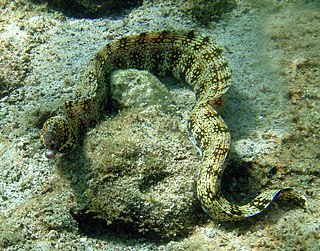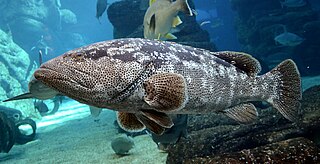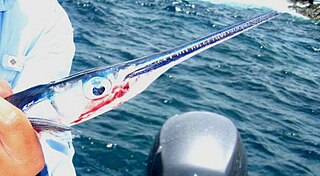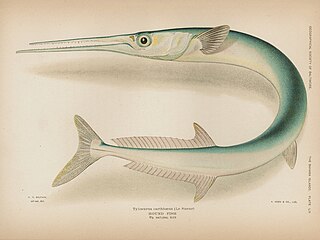
A tuna is a saltwater fish that belongs to the tribe Thunnini, a subgrouping of the Scombridae (mackerel) family. The Thunnini comprise 15 species across five genera, the sizes of which vary greatly, ranging from the bullet tuna up to the Atlantic bluefin tuna, which averages 2 m (6.6 ft) and is believed to live up to 50 years.

Mackerel is a common name applied to a number of different species of pelagic fish, mostly from the family Scombridae. They are found in both temperate and tropical seas, mostly living along the coast or offshore in the oceanic environment.

Herring are forage fish, mostly belonging to the family of Clupeidae.

Sardine and pilchard are common names for various species of small, oily forage fish in the herring family Clupeidae. The term 'sardine' was first used in English during the early 15th century; a somewhat dubious folk etymology says it comes from the Italian island of Sardinia, around which sardines were once supposedly abundant.

The zebra moray is a species of marine fish in the family Muraenidae. It is the only member of the genus Gymnomuraena, though it sometimes has been included in Echidna instead.

The snowflake moray, also known as the clouded moray among many vernacular names, is a species of marine eel of the family Muraenidae. It has blunt teeth ideal for its diet of crustaceans, a trait it shares with the zebra moray.

The Malabar grouper also known as blackspot rockcod, estuary rockcod, giant rock cod, greasy grouper, Malabar rockcod, Morgan's cod or speckled grouper, is a species of marine ray-finned fish, a grouper from the subfamily Epinephelinae which is part of the family Serranidae, which also includes the anthias and sea basses. It is found in the Indo-Pacific region. It has entered the Mediterranean Sea from the Red Sea by way of the Suez Canal as a Lessepsian migrant.

The mackerel scad, or speedo, is a species of fish of the family, Carangidae. While it can be considered gamefish, it is usually used as bait. It is popular for consumption in Hawai'i, the Philippines and the U.A.E. In Hawai'i, mackerel scad are called ʻopelu. In the Philippines they are called galunggong.

The flat needlefish, or barred longtom, the only known member of the genus Ablennes, is a marine fish of the family Belonidae. Flat needlefish are considered gamefish, frequently caught with the help of artificial lights, but are not often eaten because of their green-colored flesh.

The houndfish is a game fish of the family Belonidae. It is the largest member of its family, growing up to 5 feet (1.5 m) in length and 10 pounds (4.5 kg) in weight. It is also often called the crocodile needlefish.

The mirrorwing flyingfish is a flying fish of the family Exocoetidae. It was first described by the French zoologist, Achille Valenciennes in a 22-volume work titled Histoire naturelle des poissons, which was a collaboration with Georges Cuvier.

An anchovy is a small, common forage fish of the family Engraulidae. Most species are found in marine waters, but several will enter brackish water, and some in South America are restricted to fresh water.

The saucereye porgy is an ocean-going species of fish in the family Sparidae. In Bermuda, they are also known as the goat's head porgy. In Jamaica, they are known as the Porgi grunt and the sugareye porgy. They may also be known simply by the name Porgy in several other Caribbean islands. Saucereye porgies are considered to be minor gamefishes and when caught are marketed both fresh and frozen.
The Pacific bumper is one of two game fish in the genus Chloroscombrus, from the subfamily Caranginae of the family Carangidae, part of the order Carangiformes.

Fistularia corneta, commonly known as the Pacific cornetfish or the deepwater cornetfish, is a marine fish in the family Fistulariidae. It is endemic to the eastern Pacific Ocean, being found from California to Peru, including many offshore islands. Adult fish are found deeper than 30 metres (98 ft) and have been observed to grow longer than 1 metre (3.3 ft), but are more commonly around 20 centimetres (7.9 in) long. F. corneta feeds on small fishes, and itself is most commonly used by humans as processed fishmeal, which can be marketed as fresh, salted or dried. It is an oviparous species.
Pomadasys macracanthus, the longspined grunt or Mexican gray perch, is a species of marine ray-finned fish, a grunt belonging to the family Haemulidae. It is native to the Eastern Pacific from Mexico to Ecuador.

Sphoeroides greeleyi is a fish species described by Charles Henry Gilbert in 1900. Sphoeroides greeleyi is part of the genus Sphoeroides and the pufferfish family Tetraodontidae. No subspecies are listed in the Catalog of Life.
Diaphus similis is a species of lanternfish found in the eastern-central Pacific Ocean.

Physiculus talarae, the Peruvian mora, is a species of bathydemersal fish found in the eastern Pacific Ocean.
Physiculus nematopus, the charcoal mora, is a species of bathydemersal fish found in the eastern-central Pacific Ocean.
















